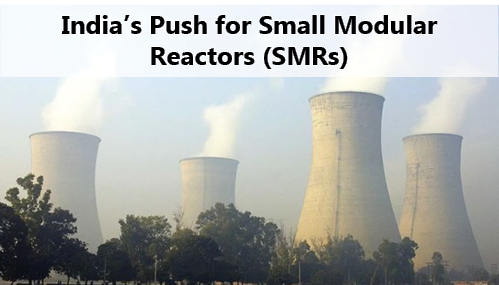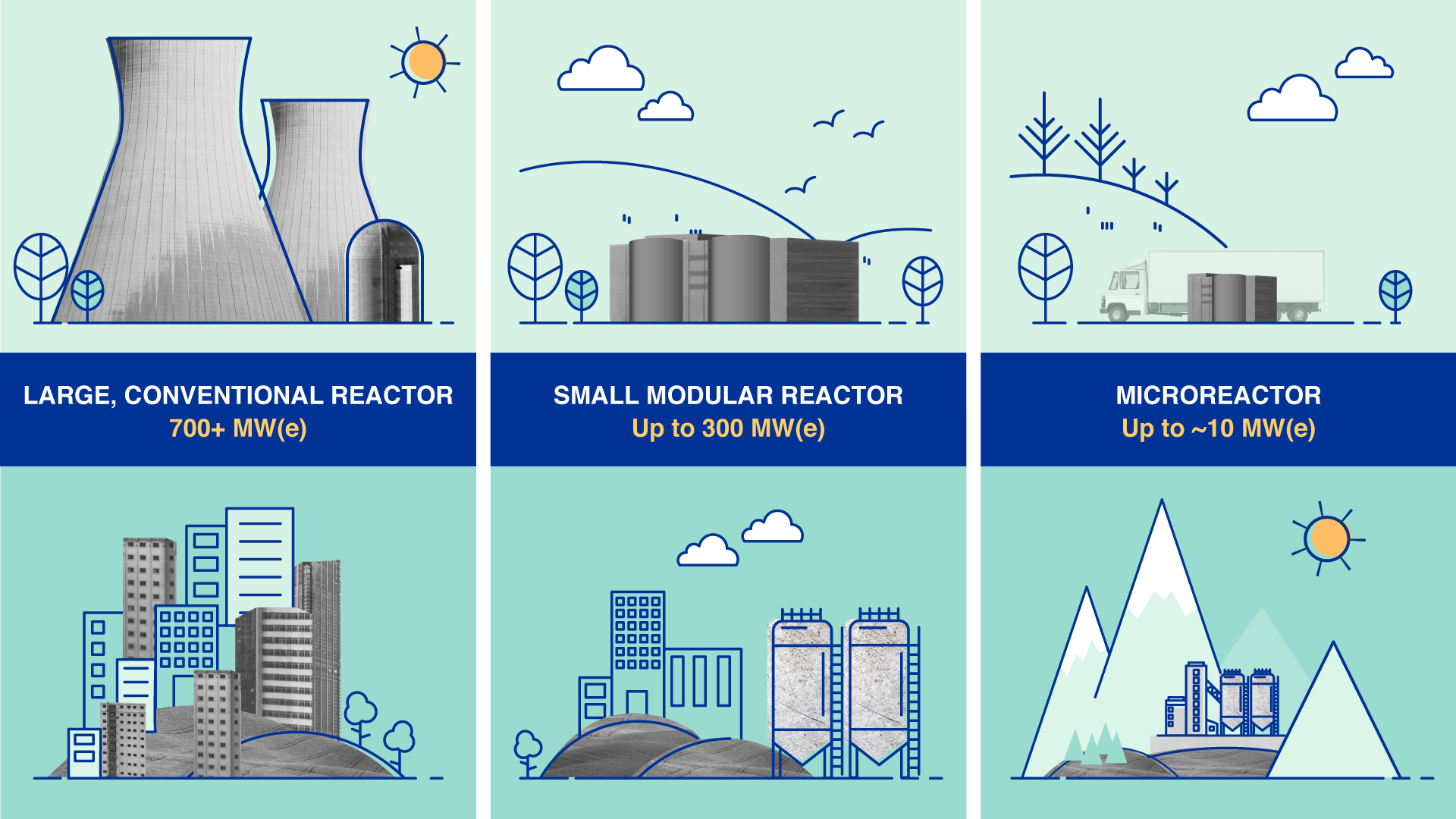Context:
India’s clean energy transition is entering a decisive phase with the government’s push for Small Modular Reactors (SMRs), compact, factory-built nuclear reactors that offer clean, safe, and flexible power generation.
-
- This marks a historic shift in India’s nuclear policy, as it opens the sector, traditionally under public sector monopoly, to private participation. About 16 sites across six states, Gujarat, Madhya Pradesh, Odisha, Andhra Pradesh, Jharkhand, and Chhattisgarh, have been identified for SMR projects.
- Under the plan, NPCIL will retain ownership and operational control, while private firms will finance the entire project, including capital and lifecycle costs. In return, they will receive rights over the net electricity generated for captive industrial use, a big advantage for energy-intensive sectors such as steel, aluminium, cement, and petrochemicals.
- This marks a historic shift in India’s nuclear policy, as it opens the sector, traditionally under public sector monopoly, to private participation. About 16 sites across six states, Gujarat, Madhya Pradesh, Odisha, Andhra Pradesh, Jharkhand, and Chhattisgarh, have been identified for SMR projects.
What are Small Modular Reactors (SMRs)?
Small Modular Reactors (SMRs) are advanced nuclear reactors with an electric power output of up to 300 MW(e) per unit — roughly one-third the size of conventional reactors.
They are defined by:
-
- Small size: Compact reactors that are easier to install and fit into existing infrastructure.
- Modular construction: Factory-made units transported and assembled on-site, cutting time and costs.
- Passive safety systems: Depend on gravity and natural circulation instead of active pumps or external power, making them safer.
- Versatile applications: Can generate electricity, produce industrial heat, hydrogen, or desalinated water.
- Small size: Compact reactors that are easier to install and fit into existing infrastructure.
SMRs can also be built underground, underwater, or on floating platforms, making them more resilient against earthquakes, floods, or sabotage. This flexibility makes them ideal for remote regions, islands, and areas with weak power grids.
Why SMRs Matter for India:
SMRs can play a major role in achieving India’s goals of energy security and clean power.
1. Low-Carbon, Reliable Power: Provide steady 24×7 baseload electricity without greenhouse gas emissions, complementing renewables.
2. Industrial Decarbonisation: Help industries generate captive clean power and reduce fossil fuel use.
3. Grid Stability: Supply stable baseload power to balance the fluctuations of solar and wind energy.
4. Repurposing Thermal Sites: SMRs can be set up at old coal plant locations, reusing land and grid links.
5. Global Alignment: Tech giants like Google and Microsoft are turning to nuclear for data centres; India’s SMR move aligns with global clean energy trends.
India’s Nuclear Energy Mission:
India aims to make nuclear power a vital part of its clean energy strategy.
Key Targets:
-
- Achieve 100 GW of nuclear capacity by 2047, in line with the Viksit Bharat vision.
- Increase installed nuclear capacity from 8,180 MW (2025) to 22,480 MW by 2031–32.
- Establish at least five SMRs by 2033.
- Achieve 100 GW of nuclear capacity by 2047, in line with the Viksit Bharat vision.
Policy Reforms:
To enable private participation, the government is considering amendments to:
1. Atomic Energy Act, 1962, and
2. Civil Liability for Nuclear Damage Act, 2010.
These reforms will allow private investment in SMR development, research, and joint ventures with NPCIL.
Indigenous Development and Technology Mix:
India’s nuclear programme has been based mainly on Pressurised Heavy Water Reactors (PHWRs) using natural uranium and heavy water. Globally, however, Pressurised Water Reactors (PWRs), using light water, are more common due to higher efficiency and scalability.
To align with global trends, the Bhabha Atomic Research Centre (BARC) is developing three indigenous SMR prototypes:
|
Reactor Type |
Power Output |
Technology Type |
Description |
|
Bharat Small Modular Reactor (BSMR) |
200 MWe |
Light Water Reactor (PWR) |
Compact modular reactor for captive use |
|
Bharat Small Reactor (BSR) |
220 MWe |
PHWR-based |
Uses heavy water and natural uranium |
|
SMR-55 |
55 MWe |
Light Water Reactor (PWR) |
Small modular design for remote or industrial sites |
Lead units of SMR-55 and BSMR-200 will be built at Department of Atomic Energy (DAE) sites as demonstration projects, expected within 60–72 months after approval.
BARC is also exploring high-temperature gas-cooled reactors for hydrogen production and molten salt reactors that can utilise India’s thorium reserves, enhancing long-term energy self-sufficiency.
Global SMR Developments:
Globally, SMRs are still at an early stage. Only two are operational so far:
1. Russia – Akademik Lomonosov: A floating SMR with two 35 MWe reactors, operational since 2020.
2. China – HTR-PM Project: A high-temperature gas-cooled SMR connected to the grid in 2021 and commercial since 2023.
Other key developers:
-
- NuScale Power (USA) – VOYGR SMR design
- Rolls-Royce SMR (UK)
- Holtec International (USA)
- Westinghouse Electric – AP300 SMR
- GE-Hitachi – BWRX-300
- NuScale Power (USA) – VOYGR SMR design
India is collaborating with the US, Russia, and France to accelerate indigenous capability and develop export-ready SMR designs.
India’s Civil Nuclear Cooperation Network:
After receiving the Nuclear Suppliers Group (NSG) waiver in 2008, India has signed several civil nuclear agreements, including:
-
- Russia: Kudankulam Nuclear Power Project (2008 IGA)
- United States: 123 Agreement (2008) enabling nuclear trade
- France: Jaitapur Nuclear Power Project
- Other partners: Canada, South Korea, Japan (2016), UK (2015), Australia, Kazakhstan, Namibia, and the EU.
- Russia: Kudankulam Nuclear Power Project (2008 IGA)
This network has strengthened India’s access to fuel, technology, and safety expertise, which will help scale up SMR deployment.
Advantages and Strategic Significance of SMRs:
1. Compact and Safe Design: Passive cooling reduces dependence on external power. For instance, the NuScale SMR (USA) can operate safely without grid power during emergencies.
2. Faster Construction: Factory fabrication improves quality and shortens timelines.
3. Scalability: Multiple units can be added as demand grows.
4. Flexible Use: SMRs can generate electricity, industrial heat, desalinated water, or hydrogen.
5. Resilience: Underground or floating SMRs, like Russia’s Akademik Lomonosov, withstand harsh environments.
6. Support for Energy Transition: SMRs will help India reach 500 GW of non-fossil fuel capacity by 2030 and meet 50% power demand from renewables, as pledged at COP26 (Glasgow, 2021).
Challenges and Risks:
1. Economic Viability: SMRs are costlier per unit of power. A 1,100 MWe reactor may cost only thrice as much as a 180 MWe unit but produce six times more electricity.
2. Safety Concerns: The US Nuclear Regulatory Commission (NRC) found that passive systems in NuScale’s SMR could face boron depletion after accidents.
3. Radioactive Waste: SMRs generate the same high-level waste per power unit as large reactors, needing similar disposal methods.
4. Fuel Supply: Some SMRs need High-Assay Low-Enriched Uranium (HALEU), which requires complex enrichment.
5. Private Oversight: Profit-driven cost-cutting could risk safety — a lesson from post-Fukushima regulations.
6. Public Acceptance: Fear of nuclear accidents and low awareness of modern safety tech remain social barriers.
Way Forward:
1. Demonstration Projects: Build first-of-a-kind (FOAK) SMRs with government support, long-term PPAs, or shared costs to reduce private risk.
2. Regulatory Strengthening: Develop an SMR-specific regulatory framework aligned with IAEA standards, covering safety, licensing, and waste disposal.
3. Public-Private Model: A hybrid NPCIL–private structure can combine efficiency and accountability.
4. Innovative Financing: Access to green finance, inclusion in green taxonomy, and low-cost credit lines can improve feasibility.
5. Safeguards by Design: Include non-proliferation safeguards at the reactor design stage itself.
6. Techno-Economic Studies: Assess emission reduction, cost-effectiveness, and efficiency before project rollout.
Conclusion:
Small Modular Reactors represent a transformational opportunity for India’s clean energy future. They can expand nuclear capacity, decarbonise industries, and enhance energy security.
| UPSC/PSC Main Question: |








